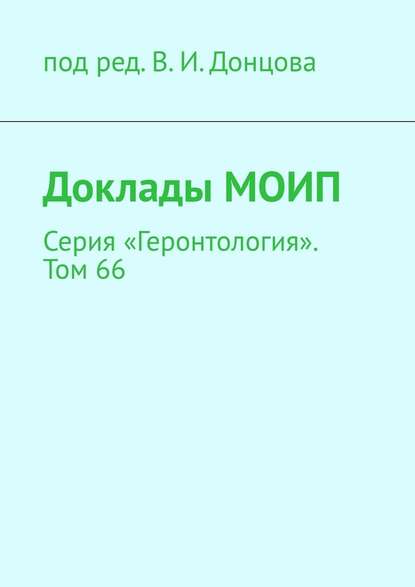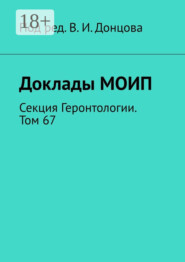По всем вопросам обращайтесь на: info@litportal.ru
(©) 2003-2025.
✖
Доклады МОИП. Серия «Геронтология». Том 66
Настройки чтения
Размер шрифта
Высота строк
Поля
Liochev S.I. Which is the most significant cause of aging? Antioxidants Basel.2015. 174: 793—810.
Lustgarten M.S. Classifying Aging As a Disease: The Role of Microbes. Front Genet. 2016. 1, 7: 212; eCollection 2016.
Marengoni A., Angleman S., Melis R. et al. Aging with multimorbidity: a systematic review of the literature. Ageing Res. Rev. 2011. 1 (10): 430—439.
Moskalev A., Chernyagina E., Tsvetkov V. et al. Developing criteria for evaluation of geroprotectors as a key stage toward translation to the clinic. Aging Cell. 2016. 15: 407—415.
Moskalev A., Chernyagina E., Kudryavtseva1 A. et al. Geroprotectors: A Unified Concept and Screening Approaches. Aging and Disease.2017. 834: 1—10.
Nikolai S., Pallauf K., Huebbe P. et al. Energy restriction and potential energy restriction mimetics. Nutr Res Rev. 2015. 282: 100—120.
Rattan S.I.S. Aging is not a disease: implications for intervention. Aging Dis. 2014. 5: 196—202.
Pinto M., Moraes C.T. Mechanisms linking mtDNA damage and aging.Free Radic Biol Med. 2015. 85: 250—258.
Rando T.A., Chang H.Y. Aging, rejuvenation, and epigenetic reprogramming: resetting the aging clock. Cell. 2012. 1481—2: 46—57.
Roth G.S., Ingram D.K. Manipulation of health span and function by dietary caloric restriction mimetics. Ann N Y Acad Sci. 2016. 3631: 5—10.
Spindler S.R. Review of the literature and suggestions for the design of rodent survival studies for the identification of compounds that increase health and life span. Age. 2012. 341: 111—120.
Strong R., Miller R.A., Astle C.M. et al. Nordihydroguaiaretic acid and aspirin increase lifespan of genetically heterogeneous male mice. Aging Cell. 2008. 7: 641—650
Zhavoronkov A., Bhullar B. Classifying aging as a disease in the context of ICD-11. Front Genet. 2015. 4, 6: 326.
Zhavoronkov A., Moskalev A. Editorial: Should We Treat Aging as a Disease? Academic, Pharmaceutical, Healthcare Policy, and Pension Fund Perspectives. Front Genet. 2016. 16, 7: 17.
Walker R. F. Developmental theory of aging revisited: focus on causal and mechanistic links between development and senescence. Rejuvenation res. 2011. 144: 429—436.
A DEVELOPMENT THE TYPICAL FOR COMMON DISEASE SYNDROMES IN THE COURSE OF NATURAL AGING AND THE VALIDITY OF THEIR CORRECTION USUAL MEDICAL MEANS
V. N. Krut’ko, V. I. Dontsov
A General approach to aging is possible only on the basis of the General System theory of aging. The system theory of aging is based on the General Model of aging of Biosystems. This model includes aging Syndromes as the most important level of aging development and is the same as the typical syndromes for any disease. This allows us to diagnose, treat and prevent aging syndomes as syndromes of any disease. Additional is the development of Age-related diseases, which also requires diagnosis and prevention also during aging. All this allows an ordinary doctor to treat the manifestations of aging as manifestations of diseases. This makes the effects on aging accessible and understandable to the Clinician.
СТАРОСТЬ КАК ВОЗРАСТ-ЗАВИСИМОЕ ОБЩЕСИСТЕМНОЕ МУЛЬТИФАКТОРИАЛЬНОЕ ЗАБОЛЕВАНИЕ, ПАТОГЕНЕЗ КОТОРОГО СООТВЕТСТВУЕТ БИОЛОГИЧЕСКОМУ ПРОЦЕССУ СТАРЕНИЯ
Б. А. Кауров
Обсуждается вопрос о взаимоотношении таких понятий как «старость» и «болезнь». Сделана попытка рассмотреть этот вопрос с формальной точки зрения, исходя из присущих этим понятиям свойств. Показано, что старость можно рассматривать как общесистемное мультифакториальное возраст-зависимое заболевание, так как оно соответствует всем формальным критериям, предъявляемым для признания данного состояния болезнью. Также показана взаимосвязь старости с другими возраст-зависимыми заболеваниями и онтогенезом.
Вы ознакомились с фрагментом книги.
Приобретайте полный текст книги у нашего партнера:
Приобретайте полный текст книги у нашего партнера:






